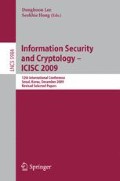Abstract
We design a new (n, 1)-CPIR protocol BddCpir for ℓ-bit strings as a combination of a noncryptographic (BDD-based) data structure and a more basic cryptographic primitive (communication-efficient (2, 1)-CPIR). BddCpir is the first CPIR protocol where server’s online computation depends substantially on the concrete database. We then show that (a) for reasonably small values of ℓ, BddCpir is guaranteed to have simultaneously log-squared communication and sublinear online computation, and (b) BddCpir can handle huge but sparse matrices, common in data-mining applications, significantly more efficiently compared to all previous protocols. The security of BddCpir can be based on the well-known Decisional Composite Residuosity assumption.
Access this chapter
Tax calculation will be finalised at checkout
Purchases are for personal use only
Preview
Unable to display preview. Download preview PDF.
References
Agrawal, R., Srikant, R.: Privacy-Preserving Data Mining. In: Proceedings of the 2000 ACM SIGMOD Conference on Management of Data, Dallas, TX, USA, May 2000, pp. 439–450 (2000)
Aguilar-Melchor, C., Gaborit, P.: A Lattice-Based Computationally-Efficient Private Information Retrieval Protocol. In: Lucks, S., Sadeghi, A.-R., Wolf, C. (eds.) WEWORC 2007. LNCS, vol. 4945, pp. 50–54. Springer, Heidelberg (2008), http://eprint.iacr.org/2007/446
Beimel, A., Ishai, Y., Malkin, T.: Reducing the Servers Computation in Private Information Retrieval: PIR with Preprocessing. In: Bellare, M. (ed.) CRYPTO 2000. LNCS, vol. 1880, pp. 55–73. Springer, Heidelberg (2000)
Breitbart, Y., Hunt III, H.B., Rosenkrantz, D.J.: On The Size of Binary Decision Diagrams Representing Boolean Functions. Theoretical Computer Science 145(1&2), 45–69 (1995)
Canetti, R., Ishai, Y., Kumar, R., Reiter, M.K., Rubinfeld, R., Wright, R.N.: Selective Private Function Evaluation with Applications to Private Statistics. In: PODC 2001, Rhode Island, USA, August 26–29, pp. 293–304. ACM Press, Newport (2001)
Carbunar, B., Sion, R.: On the Computational Practicality of Private Information Retrieval. In: NDSS 2007, San Diego, California, USA, February 27–March 2 (2007)
Damgård, I., Jurik, M.: A Generalisation, a Simplification and Some Applications of Paillier’s Probabilistic Public-Key System. In: Kim, K.-c. (ed.) PKC 2001. LNCS, vol. 1992, pp. 119–136. Springer, Heidelberg (2001)
Damgård, I., Jurik, M.: A Length-Flexible Threshold Cryptosystem with Applications. In: Safavi-Naini, R., Seberry, J. (eds.) ACISP 2003. LNCS, vol. 2727, pp. 350–364. Springer, Heidelberg (2003)
Fujita, M., McGeer, P.C., Yang, J.C.Y.: Multi-Terminal Binary Decision Diagrams: An Efficient Data Structure for Matrix Representation. Formal Methods in System Design 10(2/3), 149–169 (1997)
Gasarch, W., Yerukhimovich, A.: Computationally Inexpensive cPIR (2007), Work in progress (January 2009), http://www.cs.umd.edu/~arkady/
Gentry, C.: Fully Homomorphic Encryption Using Ideal Lattices. In: Mitzenmacher, M. (ed.) STOC 2009, May 31–Jun 2, 2009, pp. 169–178. ACM Press, Bethesda (2009)
Gentry, C., Ramzan, Z.: Single-Database Private Information Retrieval with Constant Communication Rate. In: Caires, L., Italiano, G.F., Monteiro, L., Palamidessi, C., Yung, M. (eds.) ICALP 2005. LNCS, vol. 3580, pp. 803–815. Springer, Heidelberg (2005)
Heap, M.A., Mercer, M.R.: Least Upper Bounds on OBDD Sizes. IEEE Transactions on Computers 43(6), 764–767 (1994)
Ishai, Y., Paskin, A.: Evaluating Branching Programs on Encrypted Data. In: Vadhan, S.P. (ed.) TCC 2007. LNCS, vol. 4392, pp. 575–594. Springer, Heidelberg (2007)
Kushilevitz, E., Ostrovsky, R.: Replication is Not Needed: Single Database, Computationally-Private Information Retrieval. In: FOCS 1997, October 20–22, pp. 364–373. IEEE Computer Society, Los Alamitos (1997)
Laur, S., Lipmaa, H.: A New Protocol for Conditional Disclosure of Secrets And Its Applications. In: Katz, J., Yung, M. (eds.) ACNS 2007. LNCS, vol. 4521, pp. 207–225. Springer, Heidelberg (2007)
Liaw, H.T., Lin, C.S.: On the OBDD-Representation of General Boolean Functions. IEEE Transactions on Computers 41(6), 661–664 (1992)
Lipmaa, H.: An Oblivious Transfer Protocol with Log-Squared Communication. In: Zhou, J., López, J., Deng, R.H., Bao, F. (eds.) ISC 2005. LNCS, vol. 3650, pp. 314–328. Springer, Heidelberg (2005)
Lipmaa, H.: New Communication-Efficient Oblivious Transfer Protocols Based on Pairings. In: Wu, T.-C., Lei, C.-L., Rijmen, V., Lee, D.-T. (eds.) ISC 2008. LNCS, vol. 5222, pp. 441–454. Springer, Heidelberg (2008)
Lipmaa, H.: Private Branching Programs: On Communication-Efficient Cryptocomputing. Tech. Rep. 2008/107, International Association for Cryptologic Research (2008), http://eprint.iacr.org/2008/107
Naor, M., Pinkas, B.: Oblivious Transfer And Polynomial Evaluation. In: STOC 1999, May 1-4, 1999, pp. 245–254. ACM Press, Atlanta (1999)
Paillier, P.: Public-Key Cryptosystems Based on Composite Degree Residuosity Classes. In: Stern, J. (ed.) EUROCRYPT 1999. LNCS, vol. 1592, pp. 223–238. Springer, Heidelberg (1999)
Stern, J.P.: A New And Efficient All Or Nothing Disclosure of Secrets Protocol. In: Ohta, K., Pei, D. (eds.) ASIACRYPT 1998. LNCS, vol. 1514, pp. 357–371. Springer, Heidelberg (1998)
Wegener, I.: Branching Programs and Binary Decision Diagrams: Theory and Applications. Monographs on Discrete Mathematics and Applications, Society for Industrial Mathematics (2000)
Author information
Authors and Affiliations
Editor information
Editors and Affiliations
Rights and permissions
Copyright information
© 2010 Springer-Verlag Berlin Heidelberg
About this paper
Cite this paper
Lipmaa, H. (2010). First CPIR Protocol with Data-Dependent Computation. In: Lee, D., Hong, S. (eds) Information, Security and Cryptology – ICISC 2009. ICISC 2009. Lecture Notes in Computer Science, vol 5984. Springer, Berlin, Heidelberg. https://doi.org/10.1007/978-3-642-14423-3_14
Download citation
DOI: https://doi.org/10.1007/978-3-642-14423-3_14
Publisher Name: Springer, Berlin, Heidelberg
Print ISBN: 978-3-642-14422-6
Online ISBN: 978-3-642-14423-3
eBook Packages: Computer ScienceComputer Science (R0)

